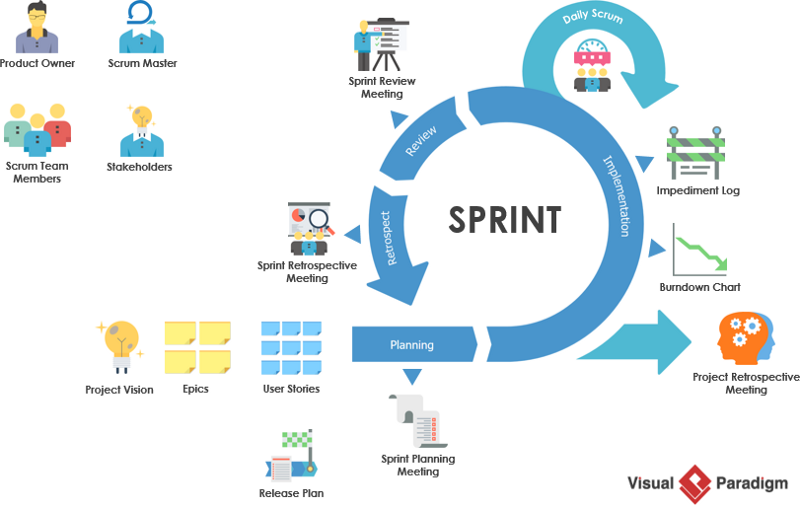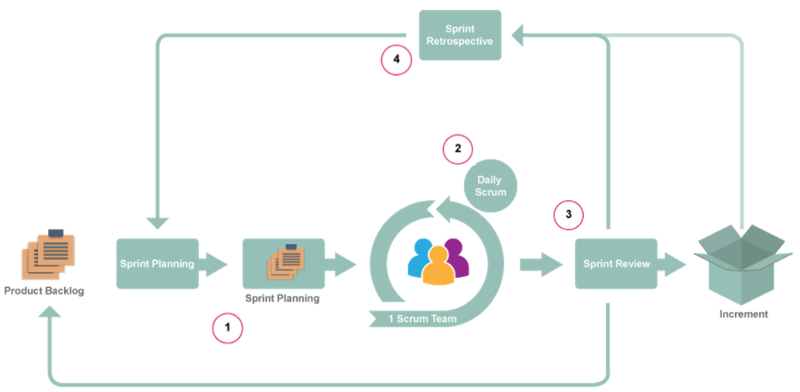Scrum là một khung làm việc trong đó mọi người có thể giải quyết các vấn đề thích ứng phức tạp, đồng thời sản xuất và sáng tạo ra các sản phẩm có giá trị cao nhất có thể.
Scrum tự nó là một khung làm việc đơn giản cho sự hợp tác hiệu quả của nhóm về các sản phẩm phức tạp. Các đồng sáng lập Scrum, Ken Schwaber và Jeff Sutherland đã viết Hướng Dẫn Scrumđể giải thích Scrum một cách rõ ràng và ngắn gọn. Hướng dẫn này chứa định nghĩa về Scrum. Định nghĩa này bao gồm các vai trò, sự kiện, sản phẩm và các quy tắc liên kết chúng lại với nhau.
Quy Trình Scrum
Trong các dự án agile, một sprint là một chu kỳ thời gian nhất quán trong đó nhóm phát triển tạo ra một nhóm khả năng sản phẩm cụ thể từ đầu đến cuối. Vào cuối mỗi sprint, chức năng mà nhóm phát triển đã tạo ra nên hoạt động, sẵn sàng để trình diễn và có thể giao cho khách hàng.

Các sprint nên có độ dài giống nhau trong một dự án. Giữ cho độ dài sprint nhất quán giúp nhóm phát triển đo lường hiệu suất của mình và lập kế hoạch tốt hơn cho mỗi sprint mới.
Các sprint thường kéo dài từ một đến bốn tuần. Bốn tuần là khoảng thời gian dài nhất mà bất kỳ sprint nào nên kéo dài; các chu kỳ dài hơn làm cho việc thay đổi trở nên rủi ro hơn, làm mất đi mục đích của việc trở nên linh hoạt. Chúng tôi hiếm khi thấy các sprint kéo dài hơn hai tuần, và thường thấy các sprint kéo dài một tuần. Các sprint một tuần là một chu kỳ tự nhiên với tuần làm việc từ thứ Hai đến thứ Sáu, điều này ngăn cản công việc vào cuối tuần.
Một số nhóm scrum làm việc trong các sprint một ngày, nơi mà các ưu tiên thay đổi hàng ngày. Nhu cầu của thị trường và khách hàng đang thay đổi ngày càng nhanh, và khoảng thời gian bạn có thể chờ đợi giữa các cơ hội để thu thập phản hồi của khách hàng chỉ ngày càng ngắn lại.
Nguyên tắc chung của chúng tôi là sprint của bạn không nên dài hơn thời gian mà các bên liên quan có thể nhất quán không có sự thay đổi về ưu tiên liên quan đến những gì nhóm scrum nên làm trong sprint.
- Mỗi sprint bao gồm các phần sau
- Lập kế hoạch sprint vào đầu sprint Các cuộc họp scrum hàng ngày
- Thời gian phát triển — phần lớn của sprint
- Một buổi đánh giá sprint và một buổi hồi tưởng sprint vào cuối sprint

Tìm Hiểu Thêm Về Scrum – Cơ Sở Agile & Scrum
- Hướng Dẫn Scrum Toàn Diện
- Ba Trụ Cột Của Scrum Là Gì?
- Phát Triển Phần Mềm Agile Là Gì?
- Scrum Trong 3 Phút
- 5 Giá Trị Của Scrum Là Gì?
- Sự Tiến Hóa Của Scrum Là Gì?
- Quản Lý Dự Án Cổ Điển So Với Quản Lý Dự Án Agile
- Tại Sao Scrum Khó Để Làm Chủ?
- Tốc Độ Trong Scrum Là Gì?
- Agile Là Gì? Scrum Là Gì?
- Chiến Lược Phát Triển Ba Người Bạn Trong Agile Là Gì?
- Kiểm Soát Quy Trình Thực Nghiệm So Với Kiểm Soát Quy Trình Định Nghĩa
- Làm Thế Nào Để Duy Trì Sự Minh Bạch Trong Scrum?
- Scrum So Với Waterfall So Với Agile So Với Lean So Với Kanban
- 3355 Trong Khung Scrum Là Gì?
- Tại Sao Scrum? Scrum Vượt Qua 8 Điểm Đau Mà Chúng Ta Luôn Đối Mặt Như Thế Nào?
- Những Công Cụ Agile Miễn Phí và Thương Mại Tốt Nhất — Mỗi Nhóm Scrum Đều Cần!
- 8 Loại Lãng Phí Trong Lean Là Gì?
- Lập Trình Cực Đoan (XP) So Với Scrum
- Timeboxing Trong Scrum Là Gì?
- Huyền Thoại Agile: Tài Liệu và Lập Kế Hoạch Không Cần Thiết?
This post is also available in Deutsch, English, Español, فارسی, Français, Bahasa Indonesia, 日本語, Polski, Portuguese, Ру́сский, 简体中文 and 繁體中文.













